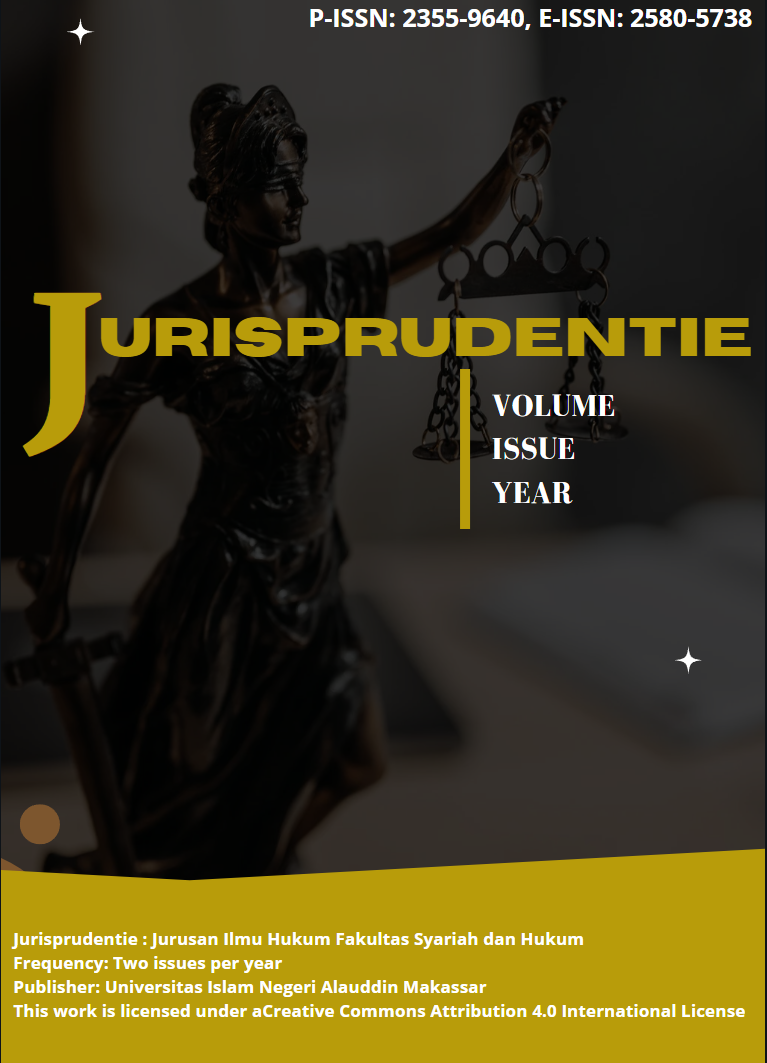Implementation Of Problem Credit Debtaccording To Civil Law
Abstract
The policy of implementing haircuts at the Bank has accelerated the restructuring of small and medium business loans. The issuance of these two decrees and the imposition of haircuts in theworld bankingfor certain parties have caused a legal problem, namely a decree has set aside all the rules stipulated in the existing laws, for example the rules regarding contract law. in the Civil Code. This is a deviation from the applicable legal principle, namely that higher regulations override lower regulations. Based on experience to achieve the expected effectiveness, it is better if thepolicy haircut through a presidential decree does not only provide discounts on bad loans but also does not limit the time interval for the loss, the important thing is that the debtor's criteria meet the requirements of SMEs affected by the monetary crisis.
Keywords: Debt Cutting, Credit, Civil Law
References
Journal
Hidayati, Maslihati Nur. "Dewan pengawas syariah dalam sistem hukum perbankan: Studi tentang pengawasan bank berlandaskan pada prinsip-prinsip Islam." Lex Jurnalicam, Volume 6, Nomor 1, (2008).
Idris, Miftah. "Kerahasiaan Bank Suatu Tinjauan Dalam Aturan Hukum Perbankan Syariah Di Indoesia." Al-Amwal: Journal of Islamic Economic Law, Volume 1, Nomor, 1, (2016).
Mansyur, M. Ali. "Aspek Hukum Perbankan Syariah dan Implementasinya di Indonesia." Jurnal Dinamika Hukum, Volume 11, Nomor 1, (2011). Umam, K. Pelarangan Riba dan Penerapan Prinsip Syariah dalam Sistem Hukum Perbankan di Indonesia. Mimbar Hukum-Fakultas Hukum Universitas Gadjah Mada, Volume 29, Nomor (3, (2017).
Umam, K. Pelarangan Riba dan Penerapan Prinsip Syariah dalam Sistem Hukum Perbankan di Indonesia. Mimbar Hukum-Fakultas Hukum Universitas Gadjah Mada, Volume 29, Nomor (3, (2017).
Wafa, Moh Ali. "Hukum perbankan dalam sistem operasional bank Konvensional dan bank syariah." Kordinat: Jurnal Komunikasi antar Perguruan Tinggi Agama Islam, Volume 16, Nomor. 2 (2017).
Books
Whim Muhammad, 2000. Banking Law in Indonesia, (Development, Prospects and Management), Citra Aditya Bhakti, Bandung.
Zanuddin Rahman, 1998. Legal Aspects of Banking Lending in Indonesia, Citra Aditya Bhakti, Bandung.
Hadiwidjaja. H. clan RA Rivai Wirasasmita, 1993. Several aspects of credit management, Pioneer Jaya, Bandung.
Asmir, 2001. Banks and Other Financial Institutions, PT. Raja Grafindo Persada, Jakarta.
Risna Wijaya, 2000. Analysis of the National Banking Crisis, Kompas Media Nusantara, Jakarta.
Kwik Kian Gie, 1998. Analysis of the National Banking Crisis, Kompas Media
Pustaka Utama and IBII School of Economics, Jakarta.
Dendawijaya, 2001. Banking Management, Ghalia Indonesia, Jakarta.
Mudrajad Kuncoro and Suharcijono, 2002. Application Banking Management, BPFE Gajah Mada University, Yogyakarta.
Munir Fuady, 2002. Introduction to Business Law, Citra Aditya Bakti, Bandung.
Rachmat Firdaus and Maya Ariyanti, 2004. Commercial Bank Credit Management (Theory, Problems, Policies and Applications Complete with Credit Analysis), Alfabeta, Bandung.
Soedradjad Djiwandono, 2001. Grappling with Indonesia's Economic Crisis and Recovery, Sinar Harapan Library, Jakarta.
Sutarno, 2004. Legal Aspects of Credit in Banks, Alfabeta, Bandung.
Cipto Darmaji, 2001. Restructuring (Mentullhkan and Accelerate National Economic WIDLGramedia, asarana Jakarta.
Single Imam Syaputra, 1999. Banking Regulation Legislation in Indonesia from 1997 to 1998, Book III, Harvarindo, Jakarta.
Lamar Basalim et al., 2000 . Perekonoiniatz Indonesia, crisis and Alternative Strategies, UNAS, Jakarta.
Regulations and Act
Law Number 10 Year 1998 on Banking,
Financial Sector Policy Committee No. KEP.01 / K.KKSK / 01/2001 On 16th January 2001
PEPRES No. 56 of 2002 concerningPolicy Haircut Non-performing Credit on Banks.
Once an article was published in the journal, the author(s) are:
- to retain copyright and grant to the journal right licensed under Creative Commons License Attribution that allows others to share the work with an acknowledgement of the work's authorship.
- permitted to publish their work online in third parties as it can lead wider dissemination of the work, with an acknowledgement of its initial publication in this journal
- continue to be the copyright owner and allow the journal to publish the article with the CC BY license
- receiving a DOI (Digital Object Identifier) of the work.


